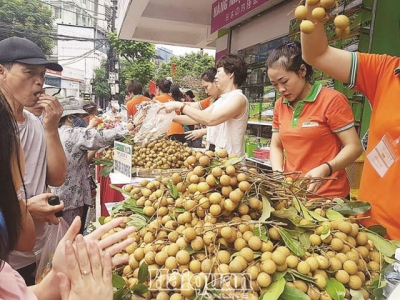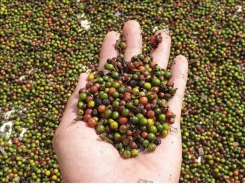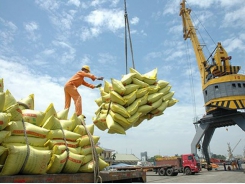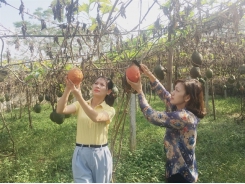Fruits and vegetables export sharply declines

Vietnam’s fruit and vegetable export has increased in 2017 and 2018, even surpassing crude oil. However, the export value of this item declined in 2019. The export target of more than US$4 billion is still difficult.
Vietnam’s fruits and vegetables export has faced difficulties in major markets
Export value sharply declines
In the last two years, while many major export agricultural products such as pepper, cashew, rubber, coffee faced difficulties and their export turnover fluctuated erratically, the price were uncompetitive. The fruit and vegetable export increased. In 2017, fruit and vegetable export reached $3.45 billion, increasing by 40.5 percent compared to 2016. China is the leading import market of Vietnamese vegetables and fruits with a market share of more than 75 percent. Fruit and vegetable exports to China in 2017 increased by more than 50 percent compared to 2016.
In 2018, although the growth rate of fruits and vegetables was not as high as in 2017, the export revenue of $3.8 billion, surpassing export turnover of crude oil, increasing by 8.9 percent compared to 2017, was a prosperity. China was still the largest export market of vegetables and fruits of Vietnam, accounting for over 70 percent of total turnover.
The vegetable and fruit export has been quite low in 2019. According to the report by the MARD's Agricultural Product Processing and Market Development Department, total export value of fruit and vegetable in the first nine months of 2019 is estimated at $2.84 billion, down 4.3 percent compared to 2018. Currently, China continues to rank first in Vietnam's vegetable import market with 73.6 percent market share. However, vegetable and fruit exports to this market in the first eight months only reached $1.8 billion, down more than 10 percent compared to the same period in 2018.
"Exports of vegetables and fruits sharply decreased due to the sharp decrease in export value of some main fruits and vegetables such as longan (down 43 percent), durian (down 20.2 percent), coconut (down 30.8 percent), water-melon (down 26.3 percent), rambutan (down 7.3 percent), wood ear mushroom (down 49.4 percent), shiitake mushrooms (down 46.6 percent), peppers (down 44.8 percent), sweet potatoes (down 39.5 percent)", the MARD's Agricultural Product Processing and Market Development Department said.
Difficult to reach target of $4 billion
Evaluating the decrease in fruits and vegetables export in this year, Dang Phuc Nguyen, General Secretary of Vietnam Fruit and Vegetable Association said the key reason is that the Chinese market has closely tightened imports. In other markers, though exports grow, turnover is low, it cannot compensate for the decline from Chinese market.
Nguyen Quy Duong- Deputy Director of Plant Protection Department (Ministry of Agriculture and Rural Development) said in May 2018, the Chinese side announced strict regulations and requirements for Vietnamese fruits exported to China via official channels as well as goods owners. Accordingly, the Chinese side required products for tracibility must be granted planting area codes and packaging facility codes. These are two requirements for legal export fruits to China.
In addition, from the end of 2018 to now, China has also tightened unofficial imports of goods. Therefore, some fruits that have a large amount of exports to China, but have not been granted official export licenses, so they are not allowed to be exported to China such as durian and coconut. Currently, the country has 47,000 hectares of durian. In the last two years, durian is considered a billion dong tree.
"Vietnam's durian is almost exclusively exported to China. Chinese people is interested in durian, even considering this fruit as the king of fruits, eating durian can bring luck. This year, durian has not been listed in official exports, so it is very difficult," Duong said.
In 2019, Vietnam's vegetable and fruit export aims to reach target of $4-4.2 billion. Currently, export turnover only reached $2.84 billion. Thus, to achieve the target of $4 billion, in the last quarter of the year, revenue from fruits and vegetables export must reach $1.16 billion. Therefore, the goal set for this year is difficult to achieve.
From now until the end of the year and in the future, the Ministry of Agriculture and Rural Development is determined to work with the Ministry of Industry and Trade to discuss with China to solve difficulties for fruits and vegetables export in general as well as other agricultural products in particular. Notably, Duong said "The Ministry of Agriculture and Rural Development has a specific plan to expand the market, promote official export to China. Currently, the item being actively promoted is durian. It is expected that durian will be officially exported to China by 2020. After durian, other potential fruits will be promoted to expand the market in China, including coconut, grapefruit, passion fruit, custard apple and avocado."
The import value of fruits and vegetables in the first nine months was estimated at $1.39 billion, up 6.8 percent compared to 2018. In particular, the vegetable item was estimated at $ 434 million, up 24.1 percent compared to 2018 and fruit item reached $ 899 million, down 2.6 percent compared to 2018.
Thailand and China are the two largest import markets for vegetables and fruits in the first eight months of this year, accounting for 35.5 percent (down 3.2 percent) and 25.7 percent (up 19.8 percent) compared to 2018. Followed by the US, Australia, New Zealand increased by 72.7 percent, 5 percent and 44.4 percent compared to 2018.
Related news
Tools

Phối trộn thức ăn chăn nuôi

Pha dung dịch thủy canh

Định mức cho tôm ăn

Phối trộn phân bón NPK

Xác định tỷ lệ tôm sống

Chuyển đổi đơn vị phân bón

Xác định công suất sục khí

Chuyển đổi đơn vị tôm

Tính diện tích nhà kính

Tính thể tích ao



 Japan: Support payments for farmers seeking feed substitutes…
Japan: Support payments for farmers seeking feed substitutes…  Women with creative start-ups see hope for future
Women with creative start-ups see hope for future